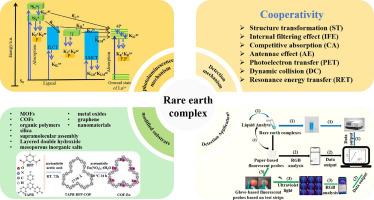稀土配合物荧光探针在检测领域的应用进展
IF 3.6
3区 物理与天体物理
Q2 OPTICS
引用次数: 0
摘要
稀土配合物具有荧光发射寿命长、色纯度高、半峰宽度窄、荧光量子效率高等特点。因此,它们被认为是制作荧光探针的首选材料。本文综述了稀土配合物的发光机理,重点介绍了稀土配合物作为荧光探针的探测机理和修饰技术。重点综述了稀土配合物荧光探针在检测金属阳离子、阴离子、生物小分子、生物大分子、硝基化合物、残留农药以及抗生素等方面的应用。最后指出了稀土配合物荧光探针有待解决的问题。展望了稀土配合物荧光探针的应用前景和发展趋势。本文章由计算机程序翻译,如有差异,请以英文原文为准。

Progress in the application of rare earth complex-based fluorescent probes in the field of detection
Rare earth complexes are characterised by a long fluorescence emission lifetime, high colour purity and a narrow half-peak width, as well as a high fluorescence quantum efficiency. Therefore, they are regarded as preferred materials for making fluorescent probes. This review introduces the luminescence mechanism of rare earth complexes, paying particular attention to their detection mechanisms and modification techniques when used as fluorescent probes. Crucially, the applications of rare earth complex-based fluorescent probes for detecting metal cations, anions, biological small molecules, biological macromolecules, nitro compounds, residual pesticides as well as antibiotics are summarized. Eventually, the problems to be solved for rare earth complex-based fluorescent probes are pointed out. Moreover, the future applications and development trends of rare earth complex-based fluorescent probes are prospected.
求助全文
通过发布文献求助,成功后即可免费获取论文全文。
去求助
来源期刊

Journal of Luminescence
物理-光学
CiteScore
6.70
自引率
13.90%
发文量
850
审稿时长
3.8 months
期刊介绍:
The purpose of the Journal of Luminescence is to provide a means of communication between scientists in different disciplines who share a common interest in the electronic excited states of molecular, ionic and covalent systems, whether crystalline, amorphous, or liquid.
We invite original papers and reviews on such subjects as: exciton and polariton dynamics, dynamics of localized excited states, energy and charge transport in ordered and disordered systems, radiative and non-radiative recombination, relaxation processes, vibronic interactions in electronic excited states, photochemistry in condensed systems, excited state resonance, double resonance, spin dynamics, selective excitation spectroscopy, hole burning, coherent processes in excited states, (e.g. coherent optical transients, photon echoes, transient gratings), multiphoton processes, optical bistability, photochromism, and new techniques for the study of excited states. This list is not intended to be exhaustive. Papers in the traditional areas of optical spectroscopy (absorption, MCD, luminescence, Raman scattering) are welcome. Papers on applications (phosphors, scintillators, electro- and cathodo-luminescence, radiography, bioimaging, solar energy, energy conversion, etc.) are also welcome if they present results of scientific, rather than only technological interest. However, papers containing purely theoretical results, not related to phenomena in the excited states, as well as papers using luminescence spectroscopy to perform routine analytical chemistry or biochemistry procedures, are outside the scope of the journal. Some exceptions will be possible at the discretion of the editors.
 求助内容:
求助内容: 应助结果提醒方式:
应助结果提醒方式:


